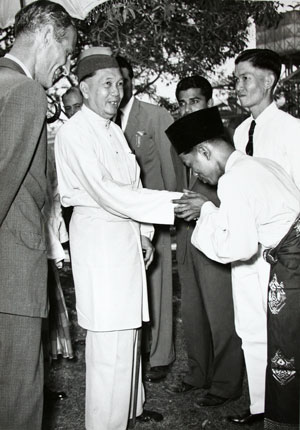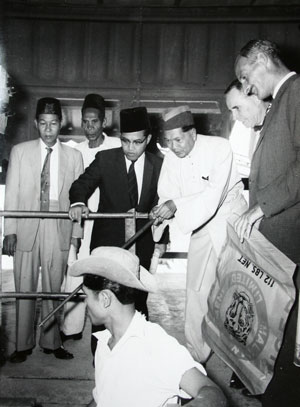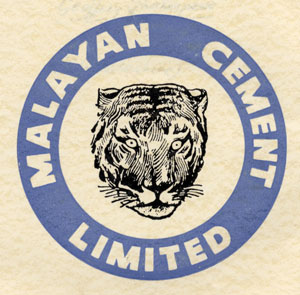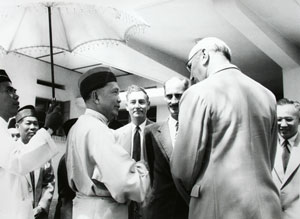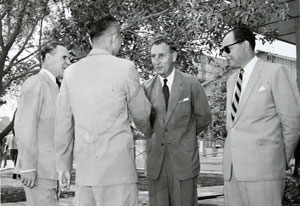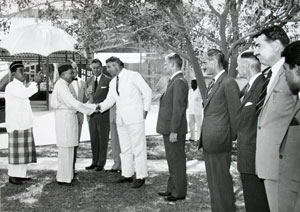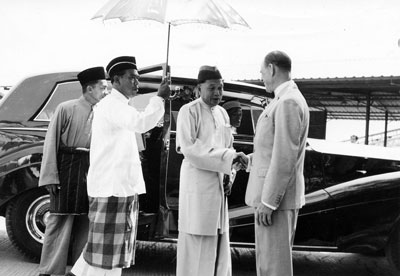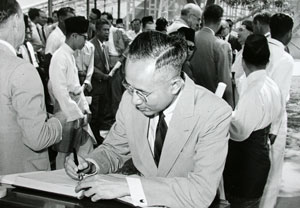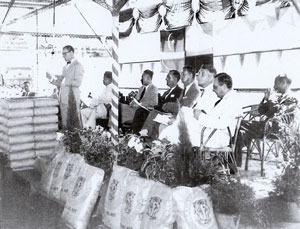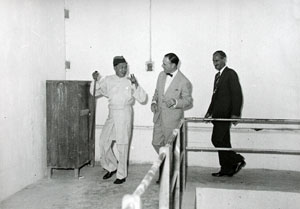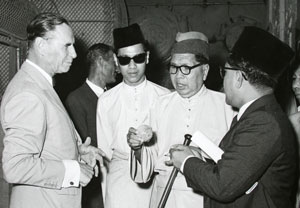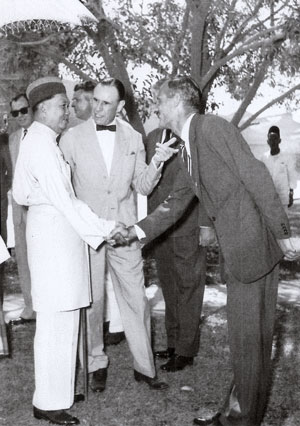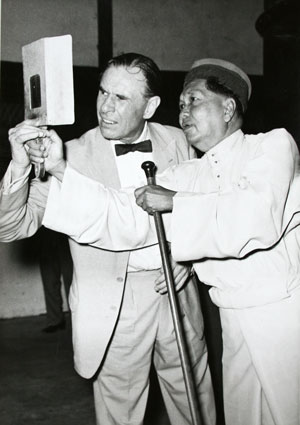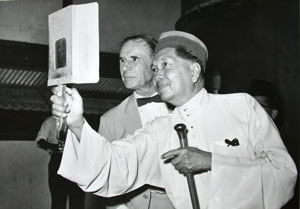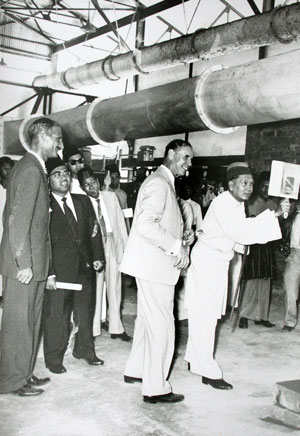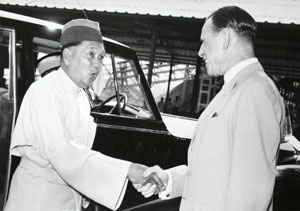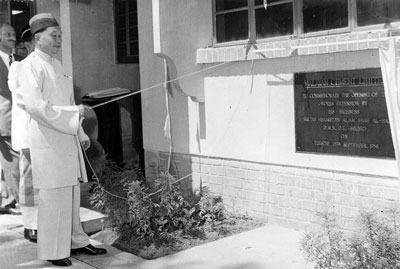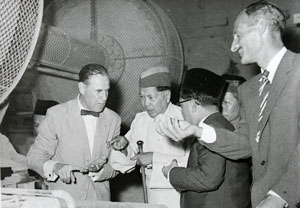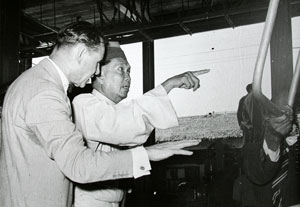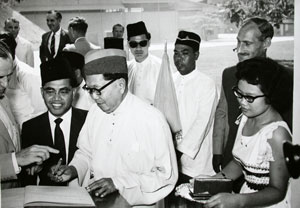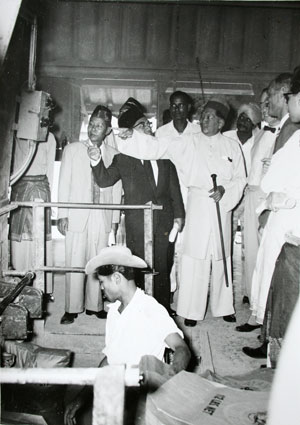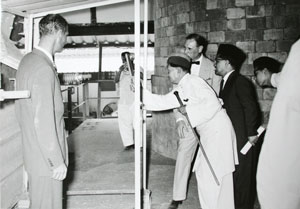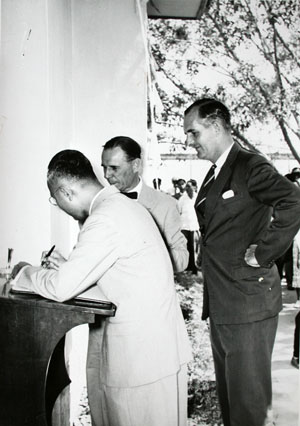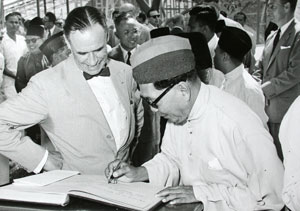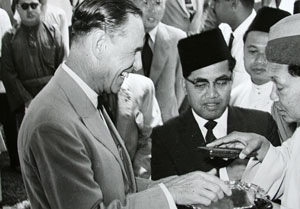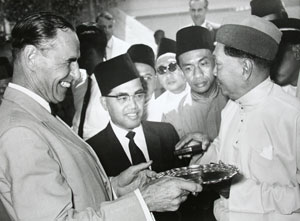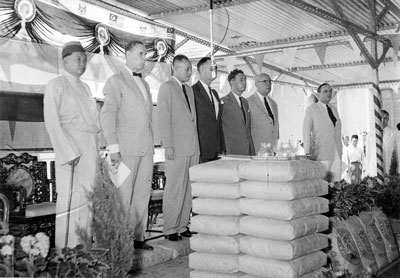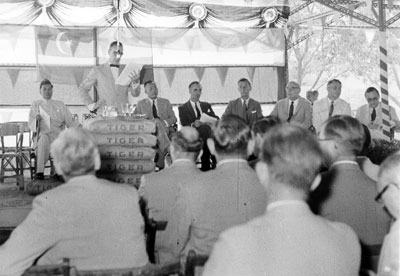For the descendents of Richard Dearie and his son John Russell
Malayan Cement. In 1959 the production of cement from the secondary rotary kiln began. This extension of the cement works was officially celebrated with a visit from the Sultan of Selangor on 15 September and the publishing of a special booklet.
The Sultan was welcomed by John Drysdale, chairman of the company. Left: Photo by Ng Bros Studio 19-21 Ampang Road, K.L.
Right: The Sultan being introduced to Mr. H. J. Hamilton, the works manager. Photo, an enlargement of a Straits Times picture.
Left: John Drysdale introduced the Sultan to some of the board of directors of the Company. From the left: The Sultan, John Drysdale, Alun Llewellyn, Harold Villiers,(in white) possibly William Dunn, Hamilton, Brian Anwell, Eden Webster and Kris Kidav. Left: Photo by Ng Bros Studio.
Left: Photo by Capital Photo Studios No. 18 Maxwell St. Rawang.
Right: Photo by Straits Times.
The visitors were given special pens to sign the book. Left: John Drysdale and the Sultan. Photo by Poon Chong Cheng. Right: This may be the Minister of Finance: Mr. Tan Siew Sin signing the book watched by John Drysdale and Mr. H. J. Hamilton.
Left: Photo by Straits Times.
Right: Photo by Poon Chong Cheng.
Left: Photo by Poon Chong Cheng.
The Sultan was given a tour of the factory. Above: Photo by Poon Chong Cheng.
Left: Photo by Poon Chong Cheng.
John Drysdale explained the process to the Sultan. Right: Photo by Poon Chong Cheng.
Left: Photo by Poon Chong Cheng.
Watching the kiln burning through a protective shield.
Right: Photo by Photo by Ng Bros Studio.
Right: Photo by Straits Times.
Watching the cement being packed into sacks.
Right: Photo by Capital Photo Studios No. 18 Maxwell St. Rawang.
The Sultan unveiled a plaque:" MALAYAN CEMENT LIMITED, TO COMMEMORATE THE OPENING OF THE WORKS EXTENSION BY HIS HIGHNESS SULTAN HISAMUDDIN ALAM SHAH AL HAJ D.M.N. D.K. (BRUNEI) ON TUESDAY SEPTEMBER 15th 1959"
Above and above left: John Drysdale giving his speech.
Left: From the left: The Sultan, John Drysdale, The Minister of Finance: Mr. Tan Siew Sin, Hunt Deputy HC, Alun Llewellyn , Sir Douglas Waring and Paul Register. Photograph by Poon Cheng Cheong 44, KG. Attap.K.L.
Mr. Tan Siew Sin's speech was reported in the Straits Times the next day.
The celebration booklet can be seen here. More on Malayan Cement here.
Thanks to Margaret Marsh for the above photographs which originally belonged to John Drysdale.
"Kris is the only one still alive and has just returned to India. He was the first Chemist ever hired there and stayed on advising the Industry until recently aged over 80." M.L. (2013)
MALAYAN CEMENT-STRAITS TIMES FEATURE $7.5 m BOOST FOR CEMENT by Saul Joshua. Factory can meet country’s needs. The Federation Government’s policy of industrial development to expand and diversify the economy of the country has encouraged Malayan cement Ltd., the only cement works in the country, to go ahead with its expansion and modernisation programme. Second kiln This expansion programme carried out at the cost of about $7,5000,000, has just been completed and today a simple ceremony to be performed by the Sultan of Selangor will mark the start of production of the second rotary kiln at the company’s factory in Rawang, Selangor. The new plant includes a second kiln, two grinding mills, extensions of existing buildings and a variety of ancillary equipment—one of them a dust collector fitted to the kilns to reduce the emission of dust from the factory chimney. Building, constructional engineering, road-making and bridging, air and sea port planning, water supplies, hydraulic power, electricity, irrigation schemes and canalisation all require cement. And with the increased demand for cement in Malaya, Malayan Cement Ltd., which produces the popular Tiger Brand Portland Cement, has initiated its extension programme to meet the new requirements. Production at the factory started in 1953 with an initial capital of $10,000,000. Now Malayan Cement has more than doubled its output from the original 100,000 tons a year to 220,000 tons. This means that Malayan Cement will be able to supply the entire cement needs of the Federation as the estimated consumption is about 250,000 tons a year. Its capacity. The Rawang factory, however, can be worked up to produce 300,000 tons annually although it has a rated capacity of nearly 230,000 tons. Malayan Cement cannot currently utilise their full capacity because: ALTHOUGH consumption of cement in the Federation totalled 245,000 tons last year, it is not expected to exceed 220,000 tons this year; and IMPORTS of foreign cements into their potential market area are pouring in and if the present rate is maintained their possible sales off take may be reduced by a further 60,000 tons this year. The company, however, hopes to capture the entire Malayan cement market with its extension programme. The company is giving active consideration to additional alterations costing a further $2,000,000 to increase its capacity to 25,000 tons a month or 300,000 tons a year within 12 months. Increased efficiency in the transportation system—one of the biggest problems in the cement trade—is among the company’s immediate plans. To make their system highly efficient, the company will add two bulk road wagons and more bulk rail wagons to its present transport fleet. As a result of this, cement will soon be available to customers in the Kuala Lumpur area in bulk, carried by special road transporters direct to job sites where it will be pumped into portable silos (storage tanks) ready for use. Advantages This method of delivery will benefit customers by a direct reduction in cost. Indirectly the advantages are: DETERIORATION of cement caused by rain and high humidity will cease; THE NECESSITY of erecting site storage for bagged cement will be obviated; SITE pilferage will be prevented; and SITE movement of cement will be eliminated, resulting in a reduction of handling and labour charges. The company also plans a new depot in North Malaya to increase the efficiency of its service to customers. New lorry loading arrangements at Rawang to facilitate and speed up the loading of customers’ lorries are also being planned. The company is currently investigating the potentiality of a combined rail and road service to enable them to offer bulk delivery to larger job sites throughout the Federation. By this method, cement will be carried in bulk rail wagons to the nearest station to the site, and then pumped into the bulk road transporters for delivery. The latest storage methods will also be introduced by the Company. (See page 12 col 5 )
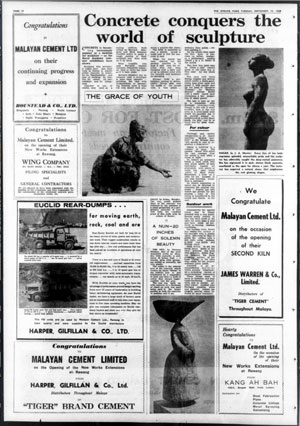
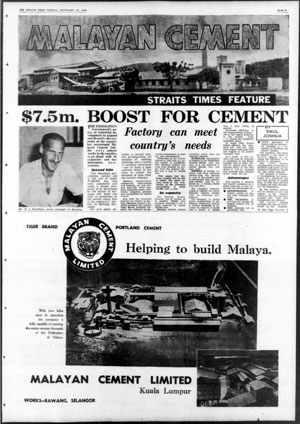
Advert TIGER BRAND—MALAYAN CEMENT LIMITED—PORTLAND CEMENT Helping to build Malaya. With two kilns now in operation the company is fully capable of meeting the entire cement demands of the Federation of Malaya. MALAYAN CEMENT LIMITED, Kuala Lumpur WORKS—RAWANG, SELANGOR.
New schemes for cheaper cement (From page One) Portable silos will be provided at work sites by the company on an easy payment basis. These improvements in transportation and storage are aimed at lowering the cost of cement to big customers. It is expected that the reduction will be about $5 a bulk ton once these methods are in full operation. The company believes that with “a lot of trade strategy” it may be able to make its cement available at a uniform price in all places in the Federation. One of the largest industrial undertakings in the Federation, Malayan Cement Ltd. is a member of the Blue Circle family, the largest cement organisation in the world. Fully tested. At the disposal of the organisation are modern research laboratories and testing plants. Chemists carry out tests at each stage of manufacture to ensure that production not only complies with the British standard specifications for Portland cement, but exceeds them by a generous margin. Consignments are sampled and tested, with a reserve sample put aside as a check against any possible complaint. The Blue Circle group has a worldwide network of cement factories—29 of them in Britain and 12 others in ten other countries. This makes it possible for Malayan Cement to call on the group’s long established experience for technical information, laboratory tests and engineering and administrative techniques. Part of the company’s present expansion programme is towards the welfare of its employees. Besides providing free housing, light and water and medical treatment, the company recently opened the Blue Circle Club to provide recreational facilities at Rawang. These include an excellent football pitch, two floodlit badminton courts and a floodlit tennis court. • Malayan Cement Ltd. have five major distributors whose names are household words throughout Malaya. They are: Boustead and Co Ltd.; Guthrie and Co Ltd.; Harper Gilfillan and Co. Ltd.; James Warren and Co Ltd.; and William Jacks and Co (M) Ltd. The fact that the Tiger cement is to be seen in godowns from Ador Star or Kota Bharu down to Johore Bahru any and every day, sight is lost of the immense amount of physical handling and work necessary to bring this about. The company’s current capital is subscribed by some 940 shareholders of whom 80 per cent reside in Malaya. Actual figures are 445 in the Federation, 300 in Singapore and 195 overseas. Despite trade setbacks, Malayan Cement made a profit of $2,723,000 last year.
Advert Congratulations to MALAYAN CEMENT LTD on their continuing progress and expansion BOUSTEAD & CO., LTD. Singapore Penang Kuala Lumpur Ipoh Kota Bharu Malacca Kuala Trengganu Kuantan Advert Congratulations to Malayan Cement Limited on the opening of their New Works Extensions at Rawang. WING COMPANY 457, BATU ROAD, -K.L.- TEL: 85632 PILING SPECIALISTS and GENERAL CONTRACTORS We are pleased to have been associated with the building of the extensions and were responsible for the construction of the reinforced concrete piers, foundation works, etc. Advert EUCLID REAR-DUMPS for moving earth, rock, coal and ore Rear-Dump Euclids are built for long life in the heavy service of mine, quarry and construction work. Their rugged construction results in less down time for repairs and more work done day after day….low cost performance that has been proved on hundreds of operations all over the world. Picture The Model UD has a capacity of 9 metric tons…is powered by a diesel engine of 128 h.p……has 10-speed gear box….spring mounted drive axle. There is a size and type of Euclid to fit every job requirement…payload capacities from 20,000 to 80,000 lbs., 9-36 metric tons…128 to 500 total h.p….5 or 10 speed gear box or torque converter with semi-automatic transmission…top speeds up to 36 mph, 58 km/h. With Euclids on your work you have the advantage of performance-proved design resulting from over 25 years of leadership in building heavy earthmoving equipment. As your Euclid dealer, we have a large stock of factory parts and an experienced staff to help keep your equipment in first class operating condition. May we give you complete information on Euclid rear-dump haulers and show you why the give the best return on investment? Picture Model FD Euclids carry 13.5 and 16.3 metric tons…have engines of 154 to 220 h.p…5 speed transmission…hydraulic power steering…quarry body optional The FD units are as used by Malayan Cement Ltd., Rawang in their quarry and were supplied by the Euclid distributors HARPER, GILFILLAN & CO., LTD. Advert Congratulations to MALAYAN CEMENT LIMITED on the Opening of the New Works Extensions at Rawang FROM HARPER, GILFALLEN & Co., Ltd. Distributors Throughout Malaya OF “TIGER” BRAND CEMENT Advert We Congratulate Malayan Cement Ltd. on the occasion of the opening of their SECOND KILN JAMES WARREN & Co., Limited. Distributors of "TIGER CEMENT" Throughout Malaya. Advert Hearty Congratulations TO Malayan Cement Ltd. On the occasion of the opening of their New Works Extensions at Rawang FROM KANG AH BAH 100-C, Bungsar Road, Kuala Lumpur. Contractors for Steel Fabrication, Pipes, Concrete Linings, Metal Spraying, Galvanising.
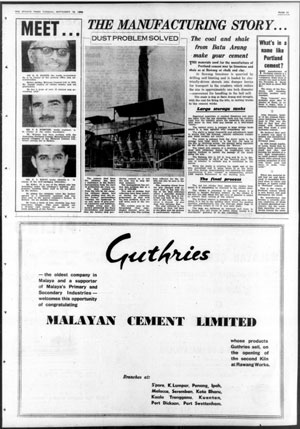
Below: The Straits Times four page supplement 15 September 1959 pages 9, 10, 11 & 12.
MEET... MR. K. M. JOSEPH, the works accountant. He is in charge of the general office and administration. Before joining Malayan Cement Ltd. in 1953, Mr. Joseph worked on rubber estates and tea plantations. He has a team of over 10 clerical and accounting staff. MR. P. E. WEBSTER, works engineer, is in charge of the entire machinery. Mr. Webster had been working with Associated Portland Cement Manufacturers Ltd., parent company of the Malayan Cement Ltd., before coming out to Malaya. MR. E. U. KIDAV, works chemist, is in charge of the well-equipped laboratory. Mr Kidav, 29, is one of the Asians who has benefitted under the company’s training programme enabling Asian staff to fill top posts at the factory. He joined the company when the factory opened as a laboratory assistant and was later sent to the parent company’s factory in Britain for six months training. He leads a team of four chemists and four laboratory hands. The team carries out a 24-hour vigil, testing the quality of the cement produced at the factory. THE MANUFACTURING STORY… The Coal and Shale from Batu Arang make your cement. The materials used for the manufacture of Portland cement may be limestone and shale as at Rawang or chalk and clay. At Rawang limestone is quarried by drilling and blasting and is loaded by electrically-driven shovels into dumper lorries for transport to the crushers which reduce the size to approximately one inch diameter—convenient for handling in the ball mill. The shale is dug at Batu Arang and brought, with the coal for firing the kiln, in railway trucks to the cement works. Large storage tanks Regulated quantities of crushed limestone and shale are taken from the raw materials store and fed continuously into the tubemill where the materials are ground with water by steel balls and emerge as a well-mixed “slurry.” The cement slurry is pumped to large storage tanks where it is kept agitated with compressed air. The slurry is tested frequently and adjustments made to ensure that the fineness, calcium carbonate content and water content are correct. The slurry is pumped from the slurry tanks to the storage tank, from which it is fed into the back of the kiln by revolving scoops, the amount being regulated by the official in charge termed the “Burner.” The rotary kiln consists of a revolving steel cylinder lined with refractory blocks. Its longitudinal axis is slightly inclined to permit the passage of the slurry along the kiln. The Rawang kiln is 315 ft. long and 9 ¼ ft. in diameter, increasing to 10 ½ ft at the “burning zone.” The rate of rotation is variable and is controlled by the burner. While the slurry is entering the upper end of the kiln, pulverised coal is being blown in at the firing end, thus drying, decarbonating and calcining the slurry, transforming it into “clinker” at temperatures around 2,500 degrees Fahrenheit in the burning zone. The final process The red hot clinker then passes into coolers from which it is transferred by conveyor to the clinker store. The clinker is conveyed to the mill where it is ground to become Portland cement. As the clinker is fed into the mill about 5 per cent of gypsum is added to prevent flash setting of the cement. The finished cement is pumped to storage silos from which it is fed to the packing plant where the packing machine automatically fills the four-ply paper bags to the specified weight of 112 lb and seals them. The bags are delivered by conveyor and chute to be loaded into rail trucks or lorries which convey it to distributors’ godowns or to the customers. What’s in a name like Portland cement? THE manufacture of Portland cement is a comparatively recent development. Some form of cement was used to build the Pyramids in Egypt as far back as about 4000 B.C. The dome of the Pantheon, still standing, provides another early example. These “cements” were probably more akin to plaster of Paris, as we know it today, than a modern Portland cement. John Smeaton, builder of the original Eddystone lighthouse in England in 1756, was the first to find that clay mixed with limestone and fired made a good hydraulic cement. He declared that such a cement was equal in solidity and durability to the best marketable Portland stone. In 1824 Joseph Aspdin, of Leeds, found that by mixing finely pulverised chalk and clay, and burning the mixture at a very high temperature, he could produce clinker which, when ground, had setting properties if used with water, sand and stone to make “concrete.” When this material itself had set and hardened, it resembled Portland stone in colour and texture, so Aspdin called it “Portland” cement. This is the origin of Portland cement which is now known and used throughout the world. Its manufacture has become a scientific process employing all kinds of highly specialised machinery, but the essentials regarding raw materials remain the same.
DUST PROBLEM SOLVED The cement dust from the chimney has been a nightmare to the factory management from the start of production six years ago. The dust, scooped up from the kiln by the escaping chimney steam, had been settling over the entire factory surroundings reducing the landscape to an ugly mass of grey-coated vegetation and buildings. People living near the factory petitioned the State Government and suggested that the factory stop producing cement as it was the only way to stop the dust nuisance. The management has settled the problem but at a cost of $450,000. Two sets of cyclone dust collectors have been installed during the extension programme to deal with the dust problem. Each set will serve each of the two kilns. The cyclone seen in the foreground (four cone-shaped objects) serve the new rotary kiln. The cyclone dust collector for the old kiln can also be seen in the picture. The escaping steam from the kiln charged with cement dust is fed into the top of the dust collectors where a powerful draught fan works. The dust is collected and falls to the bottom of the cone and the steam is cleared to give dust free chimney flue. The dust collected in the cyclones is then fed back to the kilns and the process is continuously repeated. Advert Guthries—the oldest company in Malaya and a supporter of Malaya's Primary and Secondary Industries—welcomes this opportunity of congratulating MALAYAN CEMENT LIMITED whose products Guthries sell, on the opening of the second Kiln at Rawang Works. Branches at: S’pore, K.Lumpur, Penang, Ipoh, Malacca, Seremban, Kota Bharu, Kuala Trengganu, Kuantan, Port Dickson, Port Swettenham .
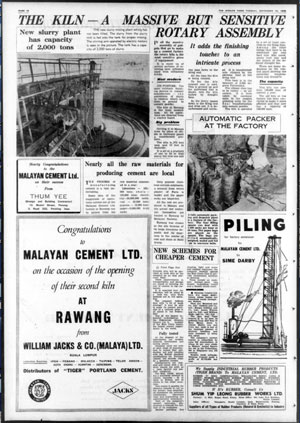
Advert: Hearty Congratulations to the MALAYAN CEMENT Ltd. on their success From THUM YEE (Dredge and Building Contractor) 15. Muntri Street, Penang. 3. Road 202, Petaling Jaya.
Advert Congratulations to MALAYAN CEMENT LTD. on the occasion of the opening of their second kiln at RAWANG from WILLIAM JACKS & CO. (MALAYA) LTD. KUALA LUMPUR. Federation Branches: IPOH – PENANG – MALACCA – TAIPING – TELOK ANSON – KOTA BHARU – KUANTAN – SEREMBAN. Distributors of “TIGER” PORTLAND CEMENT.
Advert: PILING for factory extension FOR MALAYAN CEMENT LTD. BY SIME DARBY
Advert: We Supply INDUSTRIAL RUBBER PRODUCTS (TIGER BRAND) To MALAYAN CEMENT, LTD. RUBBER ‘U; RING COMPENSATING. WELLINGTON BOOTS (LONG & SHORT), RUBBER INSERTIONS, RUBBER BUSHES, RUBBER WASHERS, PISTON ROD RUBBER PACKING RING, HEAT RESISTING PRESSURE HOSE, FLOATING RUBBER BALL VALVES, ARMOURED PRESSURE & SUCTION HOSE, CANVAS REINFORCED RUBBER BUSHES, TRIANGULAR CABLE SUSPENDERS ETC. If It’s RUBBER, Consult Us SHUM YIP LEONG RUBBER WORKS LTD. Factory: 1 ¼ Mile, Kapar Road, Klang. Head Office: 404, Loke Yew Building, Kuala Lumpur. Sales Offices: Singapore, Kuala Lumpur, Ipoh, Butterworth, Penang, Segamat & Hong Kong. Suppliers of all Types of Rubber Products (Natural & Synthetic) to Industry.
New slurry plant has capacity of 2,000 tons. THE new slurry mixing plant which has not been filled. The slurry from the slurry mill is fed into the tank for proper mixing. The stirring arm operated by electric motors is seen in the picture. The tank has a capacity of 2,000 tons of slurry. THE KILN—A MASSIVE BUT SENSITIVE ROTARY ASSEMBLY It adds the finishing touches to an intricate process IN all the massive assembly of gadgets that go to make up a cement factory the rotary kiln is the most sensitive piece of equipment. It is made up of several sections of revolving steel cylinders lined with refractory bricks. Most modern ITS PURPOSE: The most intricate finishing process in cement manufacture – the conversion of slurry to clinkers which can then be ground to cement powder. The kiln at Rawang is the most modern type. All its operations are directed from a control board. Big problem Getting it to Malaya from its place of origin in Germany posed a considerable problem. The kiln is 375 feet long and 10 feet in diameter. It is set at a gradient of one in 24 so that slurry fed into one end can pass down to the firing end. All the time the kiln is being rotated. To fire the kiln cleaned coal is used. This is ground up and the pulverised fuel is drawn into the kiln hollow by draught fans. As the slurry passes down to the firing end and dries out, it is decarbonated and calcinated. It is transformed into clinkers by the extreme heat at the firing end. The heat is in the measure of 2,500 degrees Fahrenheit. The clinker then has to be cooled—by air coolers. It is then taken by conveyor belts to the cement grinding mills for the final transformation into cement powder. The kiln is operated by a set of hand controls on the firing floor. Among the other things that have to be controlled are coal feed rate, kiln speed, slurry feed rate and the output of the induced draught fan. There are many indicators on the control panel showing the controller temperatures and draughts. The capacity This kiln can produce 150,000 tons of cement a year. The old kiln at the factory has been converted to make it more efficient and that now has a capacity of 108,000 tons. Nearly all the raw materials for producing cement are local THE PROCESS of manufacturing cement is a vast undertaking. Some idea of the magnitude of operations carried out at the Malayan Cement Ltd. factory at Rawang can be gained from the raw material consumed in a year: Limestone – 320,000 tons; shale – 105,000 tons, electricity – 30,000,000 units; coal – 85,000 tons; gypsum – 13,000 tons; paper – 5,000,000 4-ply sacks Only gypsum (hydrous calcium sulphate, a mineral from which plaster of paris is made) and the paper sacks are imported. All the rest are produced in Malaya and the actual raw materials themselves are hauled to Rawang by Malayan Railway. Rawang was chosen as the site because of its large limestone deposits and its nearness to the source of coal and shale at Batu Arang. AUTOMATIC PACKER AT THE FACTORY A fully automatic packing and dispatch plant is a feature of the factory. The four filling spouts can deal with 1,200 sacks per hour or 60 tons. The paper bags are placed on the spouts. The bags are filled automatically, weighed, sealed and fed on to conveyor belts. Nearly all the raw materials for producing cement are local THE PROCESS of manufacturing cement is a vast undertaking. Some idea of the magnitude of operations carried out at the Malayan Cement Ltd. factory at Rawang can be gained from the raw material consumed in a year: Limestone -320,000 tons; -shale- 105,000 tons; electricity -30,000.000 units; -coal- 85,000 tons; gypsum-13, 000 tons; paper -5,000,000 4 –ply sacks. Only gypsum (hydrous calcium sulphante, a mineral from which plaster of Paris is made) and the paper sacks are imported. All the rest are produced in Malaya and the actual raw materials themselves are hauled to Rawang by Malayan Railway. Rawang was chosen as a site because of its large limestone deposits and its nearness to the source of coal and shale at Batu Arang.

